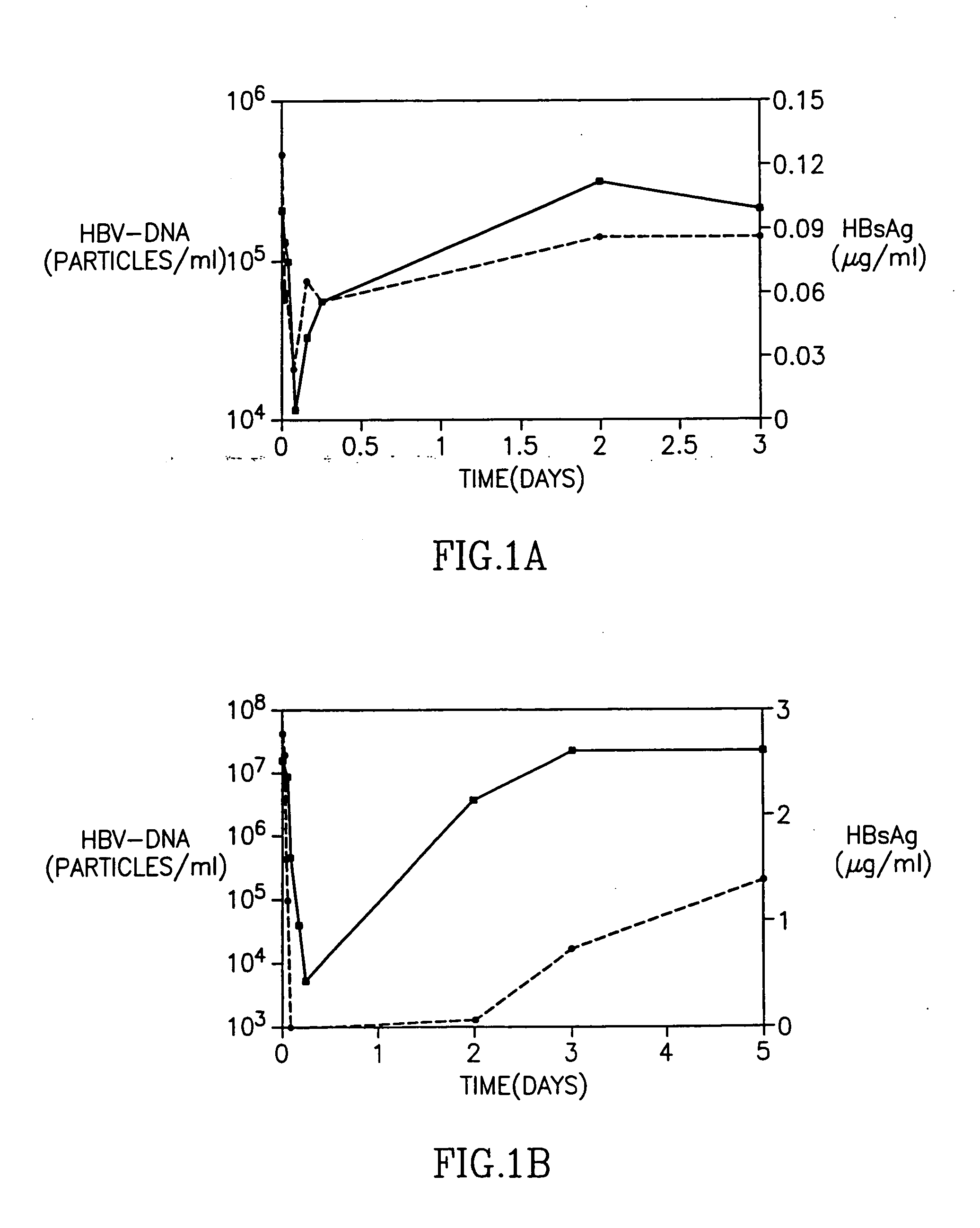Treatment of hepatitis B virus infection with human monoclonal antibodies
- Summary
- Abstract
- Description
- Claims
- Application Information
AI Technical Summary
Benefits of technology
Problems solved by technology
Method used
Image
Examples
example 1
[0021] HBV-AbXTL was first tested in a dose escalation (single-dose) phase IA study in patients with otherwise untreated chronic Hepatitis B infection (Galun et al., 2000 Hepatology 32 (4 Pt.2): p221A). A total of 15 patients were enrolled in the study and each received a single dose of HBV-AbXTL. The doses ranging between 0.26 to 40 mg. The dosing levels, were based on the molar ratio of antibody to antigen (Ab:Ag) (Table 1). HBV-AbXTL was administered as intravenous infusions over 2-8 hours.
TABLE 1Pre-treatment clinical characterization of patients in phase 1ADoseAb:AgALTHBsAgHBV-DNAPatientCohort(mg)Molar ratio(U / L)(μg / ml)(copies / ml)301I0.261:7001065.51.7 × 107302I0.261:600103.73.5 × 107304I0.261:800596.27.1 × 106303II0.261:14150.12.1 × 105305II4.71:45054853.2 × 1010101II0.321:4001344.13.0 × 103306III8.91:706118.21.8 × 109307III1.51:90752.91.8 × 102102III0.261:30270.27.0 × 106308IV301:301929.76.5 × 109309IV0.471:201860.45.6 × 106103IV3.71:10791.41.2 × 107310V391:2462.88.5 × 1062...
example 2
[0023] In a subsequent, multiple-dose, dose escalation Phase IB study of patients with chronic Hepatitis B infection, 12 patients were enrolled, three patients in each of 4 sequential dose cohorts (Table 2). Each patient received 4 weekly infusions of HBV-AbXTL at doses ranging from 10 to 80 mg per infusion. The intravenous infusions were given over 2 or 4 hours.
TABLE 2Pre-treatment clinical characterization of patients in phase 1BDoseALTHBsAgHBV-DNAPatientCohort(mg)(U / L)(μg / ml)(copies / ml)303I4 × 10140.022.0 × 105101I4 × 101233.24.6 × 103304I4 × 10694.44.0 × 103102II4 × 20560.22.2 × 107302II4 × 20492.74.0 × 106308II4 × 20949.47.0 × 108202III4 × 401941.44.0 × 1089105III4 × 40471.76.0 × 103203III4 × 40381.55.0 × 106301IV4 × 801374.63.0 × 106311IV4 × 801205.23.0 × 105106IV4 × 80870.932.0 × 107
[0024] Patients from the first cohort had received 4 weekly infusions of 10 mg each. In two out of the three patients, HBsAg levels decreased to undetectable levels immediately after administrat...
example 3
[0028] In the following study HBV-AbXTL is given in combination with lamivudine. Lamivudine is given in a dose of 100 mg / day (The recommended dose of lamivudine for treatment of chronic hepatitis B virus infection) HBV-AbXTL is given intravenously either as a 10 mg or 40 mg dose.
[0029] The preparation of these specific doses is shown in Table 3.
TABLE 3Amount of HBV-Ab 17.1.41 and HBV-Ab 19.79.5 in HBV-AbXTLHBV-Ab 17.1.41HBV-Ab 19.79.5Total mAb(2 mg / mL)(1.25 mg / mL)(mg)(IU)mLmgIUmLmgIU10 9,310 3.8 7.6 4,5601.92.38 4,7504037,24015.230.418,2407.69.5019,000
[0030] Patients are treated according to the following dosing regimen: [0031] A. HBV-AbXTL 10 mg weekly for 4 weeks followed by 10 mg every four weeks for 48 weeks plus lamivudine 100 mg once daily for 64 weeks. [0032] B. HBV-AbXTL 40 mg weekly for 4 weeks followed by 10 mg every four weeks for 48 weeks plus lamivudine 100 mg once daily for 64 weeks. [0033] C. HBV-AbXTL 40 mg weekly for 4 weeks followed by 40 mg every four weeks for...
PUM
| Property | Measurement | Unit |
|---|---|---|
| Time | aaaaa | aaaaa |
| Time | aaaaa | aaaaa |
| Mass | aaaaa | aaaaa |
Abstract
Description
Claims
Application Information
 Login to View More
Login to View More - R&D
- Intellectual Property
- Life Sciences
- Materials
- Tech Scout
- Unparalleled Data Quality
- Higher Quality Content
- 60% Fewer Hallucinations
Browse by: Latest US Patents, China's latest patents, Technical Efficacy Thesaurus, Application Domain, Technology Topic, Popular Technical Reports.
© 2025 PatSnap. All rights reserved.Legal|Privacy policy|Modern Slavery Act Transparency Statement|Sitemap|About US| Contact US: help@patsnap.com



